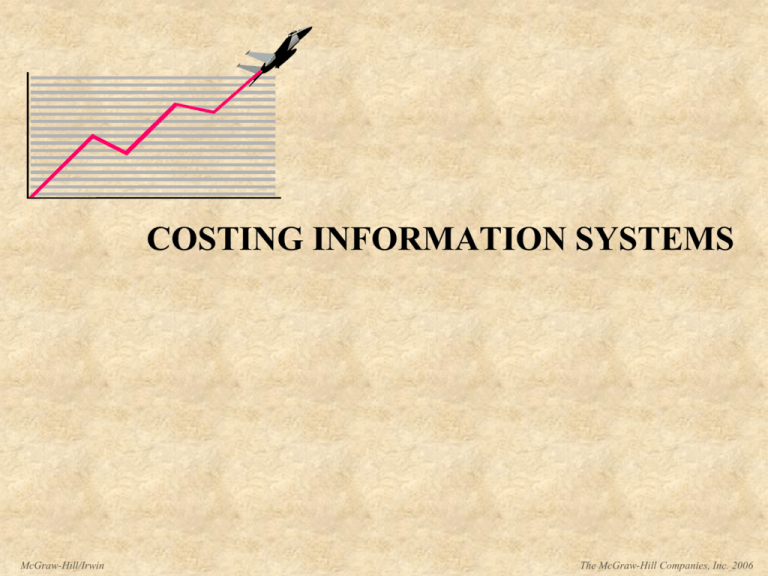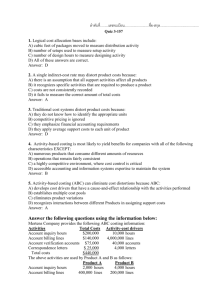ABC
advertisement

COSTING INFORMATION SYSTEMS McGraw-Hill/Irwin The McGraw-Hill Companies, Inc. 2006 4-2 Traditional Costing Systems Traditional cost systems were created when manufacturing processes were labor intensive. A single company-wide overhead rate, based on direct labor hours, may be used to allocate overhead to products in these labor intensive processes. McGraw-Hill/Irwin The McGraw-Hill Companies, Inc. 2006 4-3 Activity-Based Costing (ABC) A costing method that first assigns costs to activities, then assigns costs to products based on their use of the activities. McGraw-Hill/Irwin The McGraw-Hill Companies, Inc. 2006 4-4 Activity-Based Costing (ABC) A costing method that first assigns costs to activities, then assigns costs to products based on their use of the activities. Products Require Activities Activities Consume Resources People Manage Activities McGraw-Hill/Irwin The McGraw-Hill Companies, Inc. 2006 4-5 Activity-Based Costing (ABC) Both manufacturing and nonmanufacturing costs may be assigned to products. ABC is a good supplement to our traditional cost system. A Allocation bases often differ from traditional costing systems. McGraw-Hill/Irwin B C ABC is used primarily for decision making The McGraw-Hill Companies, Inc. 2006 4-6 Activity-Based Costing (ABC) Activity-Based Costing Traditional Costing McGraw-Hill/Irwin The McGraw-Hill Companies, Inc. 2006 4-7 Activity-Based Costing (ABC) Traditional Costing Resource Costs Directly traced or allocated Cost Pools: Plants or Departments Predetermined overhead rate Cost Objects McGraw-Hill/Irwin Activity-Based Costing Resource Costs Directly traced or allocated Cost Pools: Activities or Activity Centers Cost driver rates for each activity Cost Objects The McGraw-Hill Companies, Inc. 2006 4-8 Activity-Based Costing (ABC) Costs An Activity Cost Pool is a “container” in which costs are accumulated that relate to a single activity in the ABC system. McGraw-Hill/Irwin $$ $ $ $ $ The McGraw-Hill Companies, Inc. 2006 4-9 Four Steps in the ABC Process Identify and classify the activities related to the company’s products or services. Estimate the cost of each activity identified in . Calculate a cost-driver rate for each activity. Assign activity costs to products using the cost-driver rate. McGraw-Hill/Irwin The McGraw-Hill Companies, Inc. 2006 4-10 When Should a Company Use ABC? Indirect costs are significant in proportion to direct costs. Goods are complex, requiring many inputs and processes. Different departments believe costs are assigned inaccurately. The company loses bids it thought were low, and wins bids it thought were high. Operations have changed significantly, but the costing system has not changed. McGraw-Hill/Irwin The McGraw-Hill Companies, Inc. 2006




